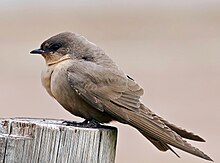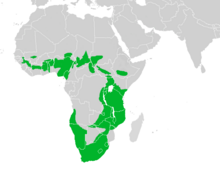
Back Kransswael Afrikaans سنونو الصخر Arabic Ptyonoprogne fuligula AST Kiçik qaya qaranquşu Azerbaijani Африканска лястовица Bulgarian রক মার্টিন Bengali/Bangla Ptyonoprogne fuligula Breton Roquerol isabelí Catalan Ptyonoprogne fuligula CEB Gwennol y graig Welsh
| Rock martin | |
|---|---|

| |
| At the Karoo National Park, Western Cape, South Africa. | |
| Scientific classification | |
| Domain: | Eukaryota |
| Kingdom: | Animalia |
| Phylum: | Chordata |
| Class: | Aves |
| Order: | Passeriformes |
| Family: | Hirundinidae |
| Genus: | Ptyonoprogne |
| Species: | P. fuligula
|
| Binomial name | |
| Ptyonoprogne fuligula (Lichtenstein, MHC, 1842)[2]
| |

| |
Approximate range
| |
| Synonyms | |
|
Hirundo fuligula Lichtenstein, 1842 | |
The rock martin (Ptyonoprogne fuligula) is a small passerine bird in the swallow family that is resident in central and southern Africa. It breeds mainly in the mountains, but also at lower altitudes, especially in rocky areas and around towns, and, unlike most swallows, it is often found far from water. It is 12–15 cm (4.7–5.9 in) long, with mainly brown plumage, paler-toned on the upper breast and underwing coverts, and with white "windows" on the spread tail in flight. The sexes are similar in appearance, but juveniles have pale fringes to the upperparts and flight feathers. The former northern subspecies are smaller, paler, and whiter-throated than southern African forms, and are now usually split as a separate species, the pale crag martin. The rock martin hunts along cliff faces for flying insects using a slow flight with much gliding. Its call is a soft twitter.
The rock martin builds a deep bowl nest on a sheltered horizontal surface, or a neat quarter-sphere against a vertical rock face or wall. The nest is constructed with mud pellets and lined with grass or feathers, and may be built on natural sites under cliff overhangs or on man-made structures such as buildings, dam walls, culverts and bridges. It is often reused for subsequent broods or in later years. The rock martin is a solitary breeder, and is not gregarious, but small groups may breed close together in suitable locations. The two or three eggs of a typical clutch are white with brown and grey blotches, and are incubated by both adults for 16–19 days prior to hatching. Both parents then feed the chicks. Fledging takes another 22–24 days, but the young birds will return to the nest to roost for a few days after the first flight.
The rock martin is often predated on by several fast and agile species of falcon, such as the hobby, and it sometimes carries parasites. Because it is common within its large range with an apparently stable population, it is assessed as a least-concern species on the IUCN Red List.
- ^ "Ptyonoprogne fuligula". IUCN Red List of Threatened Species. 2016. BirdLife International: e.T104005679A94325303. 2016. doi:10.2305/IUCN.UK.2016-3.RLTS.T104005679A94325303.en. Archived from the original on 22 October 2020. Retrieved 19 June 2021.
- ^ Lichtenstein, Martin (1842). Verzeichniss einer Sammlung von Säugethieren und Vögeln aus dem Kaffernlande, nebst einer Käfersammlung [Directory of a collection of mammals and birds from the Kaffir country] (in German). Berlin: Royal Swedish Academy of Sciences. p. 18.
© MMXXIII Rich X Search. We shall prevail. All rights reserved. Rich X Search
